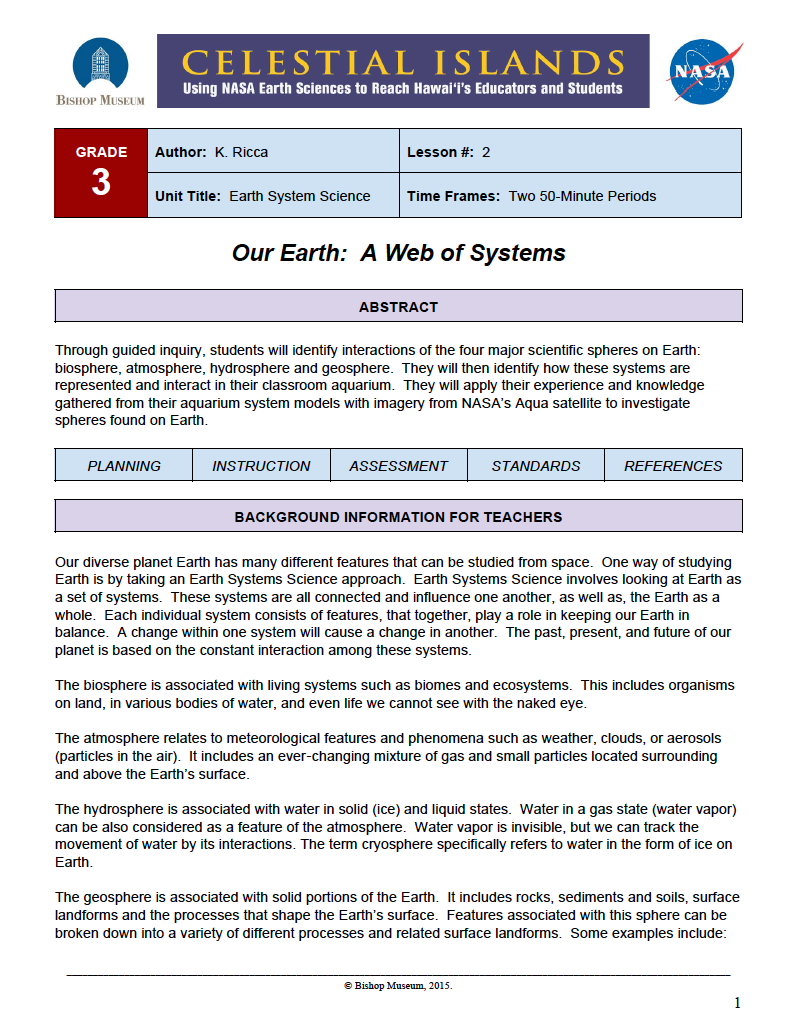Lesson Plans
Our Earth: A Web of Systems
Overview
Through guided inquiry, students will identify interactions of the four major scientific spheres on Earth: biosphere, atmosphere, hydrosphere and geosphere. They will then identify how these systems are represented and interact in their classroom aquarium. They will apply their experience and knowledge gathered from their aquarium system models with imagery from NASA’s Aqua satellite to investigate spheres found on Earth.
Materials Required
- Class aquariums
- The Globe Program: All About Earth, Our World On Stage
- Earth’s Spheres PowerPoint presentation
- Digital Projector
- Class set of “Earth’s Spheres,” “Sphere Interactions” and “Session Two Assessment” worksheets
- “Earth System Song” for each student
- Poster board and art/craft materials
- The Air We Breathe (optional)
Preparation
- Make class sets of worksheets and the “Earth System Song”
- Download “Earth’s Spheres” PowerPoint presentation
- Provide posterboard and art materials
- Set up class aquariums so they are visible to students
Disciplinary Core Ideas:
- ESS1C: The History of Planet Earth
Crosscutting Concepts:
- Patterns
- Systems and System Models
Science and Engineering Practices:
- Developing and Using Models
- Planning and Carrying out Investigations
- Constructing Explanations and Designing Solutions
Students will:
- Identify and describe Earth’s four spheres.
- Formulate new understandings of Earth’s spheres.
- Recognize and explain the interactions between Earth’s spheres found in aquarium model.
- Communicate their understandings in discussions, with a science notebook and an organizing worksheet.
- How do I fit into Earth’s systems?
- How can observing our aquarium system model help us figure out what’s happening in the Earth’s systems?
Our diverse planet Earth has many different features that can be studied from space. One way of studying Earth is by taking an Earth Systems Science approach. Earth Systems Science involves looking at Earth as a set of systems. These systems are all connected and influence one another, as well as, the Earth as a whole. Each individual system consists of features, that together, play a role in keeping our Earth in balance. A change within one system will cause a change in another. The past, present, and future of our planet is based on the constant interaction among these systems.
- The biosphere is associated with living systems such as biomes and ecosystems. This includes organisms on land, in various bodies of water, and even life we cannot see with the naked eye.
- The atmosphere relates to meteorological features and phenomena such as weather, clouds, or aerosols (particles in the air). It includes an ever‐changing mixture of gas and small particles located surrounding and above the Earth’s surface.
- The hydrosphere is associated with water in solid (ice) and liquid states. Water in a gas state (water vapor) can be also considered as a feature of the atmosphere. Water vapor is invisible, but we can track the movement of water by its interactions.
- The term cryosphere specifically refers to water in the form of ice on Earth.
- The geosphere is associated with solid portions of the Earth. It includes rocks, sediments and soils, surface landforms and the processes that shape the Earth’s surface. Features associated with this sphere can be broken down into a variety of different processes and related surface landforms. Some examples include erosion, volcanism, and plate tectonic movement. Alternate terms that also refer to these terrestrial features are lithosphere or crust.
- Standalone Lesson (no technology required)


